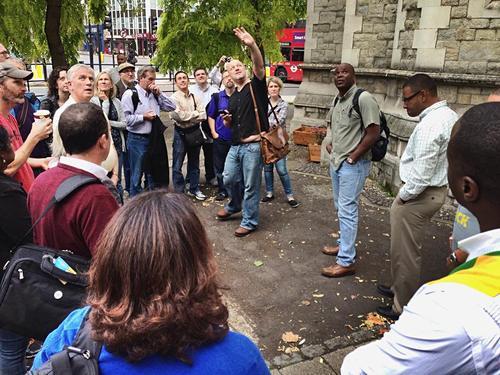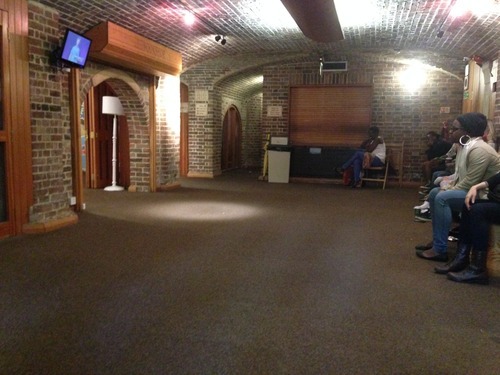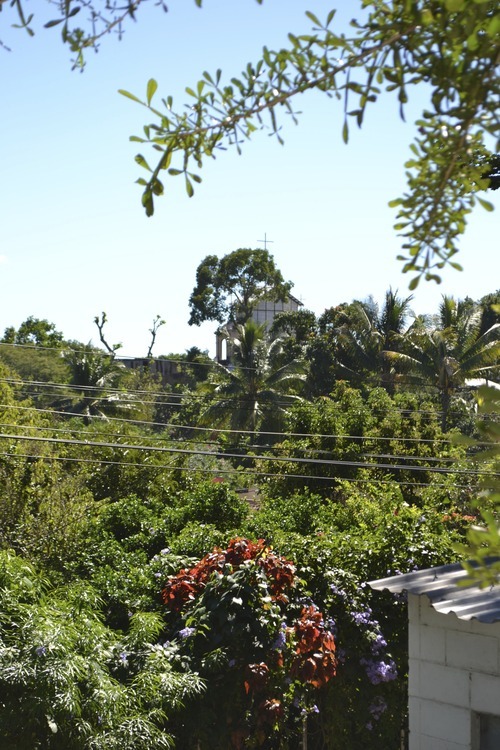Look Up
So much to look at, so much to see. If you’re not careful you could miss something important. If you’re caught looking the wrong way at the wrong time, then you might miss the next thing.

Our visit to Oasis Church really captivated my attention. Despite the fact that this picture of our group shows that everyone else is looking up while I am looking down, I think it is evident that my thoughts were churning. At this point in our visit, Jason Clarke was sharing with us that Abraham Lincoln had sent the money to this church for the building of its spire. It was an act of gratitude to this congregation for their part in helping to abolish slavery. 
This church, at that time was led by Reverend Roland Hill, for nearly fifty years (1783 to 1833). This church (to my understanding) served as a connecting point for John Newton (who wrote the hymn Amazing Grace) and William Wilberforce, whose perseverance for faith and justice brought down slavery in the United Kingdom. This church (at that time named Surrey Chapel) was used of God to address a deep injustice in the local context, which God then used to bring justice to other parts of the world. The spire is a reminder of God’s sovereignty and power in an era where people were blind to their sins of oppression, hatred and self-indulgence. This church in our current times, is still being used to address issues of social injustices (http://www.oasischurchwaterloo.org).

As I considered their past and looked up to the spire, I felt as though God was reminding me of something: His purposes will prevail. He is sovereign. We just need to look up, to Him. So…I did…repeatedly. The act of looking up above the coming and going of the crowds became a powerful reminder to me that God had indeed at some point in time impressed His Truth, Love and Purpose on a community of people. Too often we look straight ahead at the people, the circumstances, even the traffic and feel as though God is absent or there is no room for Him here. But if we look up, we’ll see that He has left tangible reminders for us. They are reminders that He, at some point in time, had established his presence in a particular community. They are reminders that have the potential to provide new connection points for those who take the time to consider.
Related to this, was our “homework” outing on Sunday morning. We were to attend a church service. While many opted to go in groups to various places, my desire was to go alone. There were two main reasons for this choice. The first is that I didn’t want to have to synthesize my experience with anyone else or through anyone else’s perspective. Secondly, being a pastor, I often know what to expect and when to expect it during a service. The opportunities to attend a service as a co-worshipper are something I deeply value and generally find enriching. This one did not disappoint.
I chose to attend the late morning service at Holy Trinity Brompton. I was late arriving and it quickly became obvious that I had approached the building from the wrong side. I found an open door and let myself in, trying to inconspicuously find a seat. Unknowingly, I had let myself into the door that was right beside the platform. When questioned, I apologized for my tardiness and explained the innocence of my situation. One of the men offered to help me find a seat by going through the door beside the platform and up through the crowd until a vacant seat could be found. “That doesn’t seem to be a good idea” was the thought that went through my mind, as I quickly put myself in the position of the person who was speaking, knowing what kind of distraction that would be to him. Instead, seeing a room with a couch, a couple of chairs and a television monitor off to the right, I respectfully offered to sit there. I had now put my unprepared host at a greater level of discomfort, “That’s the green room, it’s for those who are participating in the service.” Well at least he didn’t say it’s for “special people”. To make a short story longer, I quickly excused myself out the door I had entered and ventured around until I could find another entrance.
Before long I did find another entrance, on the bottom floor, across from the bookstore and toddler area. I sat down, quieted my spirit and listened to the audio through the speakers and watched the monitor on the wall. There were about a dozen others with me. To my right, someone who looked oriental. To my left, someone of African descent. Across from me a Belgian husband and wife with their young child. A few others came, it was a true multicultural mix. But then it happened. The message ended and the singing began.

Through the ceiling above us, we could hear the rhythmic shuffling of feet and hear the joyously raised voices. Without even considering the others, I felt myself singing and realized they too were singing, just a few of us, seemingly disconnected from the others, yet mysteriously joined together in the worship of our God. It is a moment that has continued to grip my attention. It was a reminder that God is sovereign and powerful. Despite the fact that I was late, despite the fact that I could not get a seat, despite the fact that I sat with a dozen people removed from the assembly above, the presence of God was tangible. Here we were people of different ethnicities, likely differing native languages (give or take a generation) worshipping the Lord together. This is why I came.
New Knowledge
The advance of time doesn’t necessarily mean that the source of hope for humanity needs to change. There is an ancient-future aspect that was consistent throughout the Advance experience, showing us that it is necessary to keep the foundations and tested truths of the past in order to address current needs and position ourselves for future opportunities. Some of what I observed is as follows:
- The “new” methods of Jeremy Crossley as he addresses the needs of business professionals from his aged parish. In simplicity God’s truth is dispensed and people are free to come and sample or take part in greater fashion. A new approach in an old setting that is still faithful to its intended purpose.
- The “old” methods of Lloyds of Londons though they are fully modernized, somehow retaining their hold as one of the most prosperous companies in the world. An old approach in a new setting that is still faithful to its intended purpose.
- The “new” innovations in ministry of Oasis Church which are remarkably faithful to the vision (discussed above) of its founding from centuries before.
- The mix of both “new” and “old” architecture that make London one of the most fascinating cities in the world.
- The “new” mutlti-national mix of people at ground level under the “old” crosses that can be seen across the skyline of London.
The constant mix between old and new, in strategy, buildings and even people continued to draw my attention. Somehow there had to be this connecting piece that held the tension that is inherent to this mix. That connection, I determined, must be God. The problem is that this connection to God isn’t apparent to everyone. In fact it seems as though there are fewer people making that connection while piling up more layers of new upon the old in search of meaning and significance.
Therefore, it is necessary for me, in my role as a Christ-following person, pastor or leader to be intentional in inviting people to pause, reflect and re-consider their current lives and experiences in view of our timeless God who is still Sovereign over us.
Practice
Since my experiences in London, I have been much more intentional to look up and find the tangible reminders from our Omnipresent God that He is in control. In finding those reminders, I have not necessarily found solutions to the problems, issues and struggles for the people whom I serve, but I have found the consistent return to worship God, entrusting the lives of people to Him and have more readily been willing to lean heavily upon His Truth and Spirit to be our guide. In return I have been renewed in strength and resolve despite the challenges of ministry, being involved in our community and helping to raise a family of two teenagers.
In the book by Stanley Grenz and Roger Olse, Who Needs Theology?: An Invitation to the Study of God, they created a refrain that is often repeated throughout the book. That refrain, “Who needs theology?” is an invitation to continually pour the questions of life (and God), from our head through our heart, using the filter of God’s truth to give purpose to our actions. That theme weaves its way through this book. It is the theme of reflection (Loc. 191-193). Creating space in order to allow ourselves to consider carefully what we are reading is integral to this process as it allows us to delve a little deeper in the critical reasoning and questioning that is crucial to establishing a firm foundation. Unfortunately, for many, the pace at which we run our lives allows little time for reflection.
Application
Throughout this semester, the theme of reflection has been a theme that has captured my attention. In the book, Christian Theology, by Alistair McGrath, he addresses the need for reflection in deepening our understanding of God. McGrath does acknowledge the significance of personal engagement in the task of theology when he writes: “However, the consensus within Christian theology as a whole is that this process of dialogue and reflection is both helpful and productive, and is integral to the theological task.” (p.107). Reflection can’t be something that occurs in the hope that everything else will stop or our never-ending list of duties will subside. In an increasingly complex world, we need to intentionally invite God to help us make sense of what is going on around us. Reflection needs to be an intentional tool in the tool belt of every leader, and over the course of these few months I’ve tried to engage that more in my personal life and among those with whom I serve.
Recently I travelled to El Salvador with a short term mission team from our church (www.semcelsalvador.blogspot.com). Our work consists of building houses for those considered the poorest people in various regions. Some arrive at their current location by choice, others have been displaced by the devastation caused by natural disasters. Either way their living conditions are meager and their optimism for the future is difficult to find. They lack confidence in themselves, trust in others and hope that any change is possible.

One of the goals of our trip is to foster relationships with the people receiving the homes, in partnership with a local church, for the purpose of helping them discover the gifts and abilities that God has given them to either persevere through poverty or overcome it’s effects.
Our team came equipped to share their own story of how God had transformed their lives. On one such occasion after a member of our team shared his story with a small group of locals, someone thanked us for coming to help them as poor people. This word, “poor”, had never stood out to me the way it did that day. They see themselves as poor, forgotten, abandoned and alone.
However to us it seemed the opposite was true. They had so much of what we desired: joy, community, willingness to share and co-labour, hospitality and a desire to work hard. They weren’t poor, they were rich, at least in our eyes. They possessed qualities that we often long for and it was up to us to remind them of that. Our relationship with them grew because of it.
Just that morning as I was looking up and out over the hillside, I saw three crosses raised above the trees. They came from a city church. It was a reminder that God, at some point, had established his presence in this community.

The promise of redemption and identity that comes through the cross is so transformational to our lives. If we only see life through horizontal relationships then we are doomed to despair, loneliness and poverty. However, given the invitation to reflect upon the fact that God is still in control, working out His purposes, hope can be renewed and the weak can be made strong. Our team had the privilege of sharing that story, and lifting the eyes of this local village to recognize that through Jesus Christ, they are not poor, but counted among the richest of people.
The capacity to help people think through their lives on a theological level, knowing that God’s truth intersects the essential questions of their lives is as vital today as it appears in the biblical narratives. Therefore, it ought to be important to us because through this type of engagement we obtain the wisdom that is required for everyday living. David Ford indicates in his book Theology: A Very Short Introduction, “Wisdom is not just concerned about more information and knowledge but also how they relate to other … (wisdom) deals with dimensions of life that much academic learning tends to bracket out, such as suffering, joy, or the purpose of existence.” (p.165) The real life application of God’s truth is at the heart of engaged theological questions and thinking. Theological reflection was what was taking place on the mountainside in El Salvador that day.
That conversation changed the way we interacted with this community. It opened the door for us to pray for them, encourage them and empower them to understand the uniqueness of their identity from God’s perspective. No longer were we the donors and they the receivers. There was now a mutual exchange, where in we also we learning about the qualities that are so lacking in our fast-paced world. Our theology, understanding of God and His truth, was deepened through this collaborative exchange we call relationship.
Sarah Pink made a statement in her book, Doing Visual Ethnography: “Collaborative photography usually involves ethnographers engaging in some way with the photographic culture of their informants.” (loc. 1444) Throughout her examination of multiple mediums of communication, Pink repeatedly returns to this concept of collaboration. The importance of developing and communicating meaning through shared engagement between the photographer and the informant. It is the combination of the image(s), the context and their significance that allow others into the story being told.
My experiences throughout the course of these last few months have served to bring validation to these statements. Previously I would have taken a picture and given my interpretation of what that meant, excluding input (though not intentionally) from the informants. However, I have come to realize all the more the added value and richness of taking time to synthesize the perspectives of the informants together with my own perspective and then submit all of it to the Sovereignty of God. Looking up has been an important part of that.
I lift my eyes up to the hills
Where does my help come from?
My help comes from the Lord,
The Maker of heaven and earth.
(Psalm 121:1-2, NIV)

Leave a Reply
You must be logged in to post a comment.